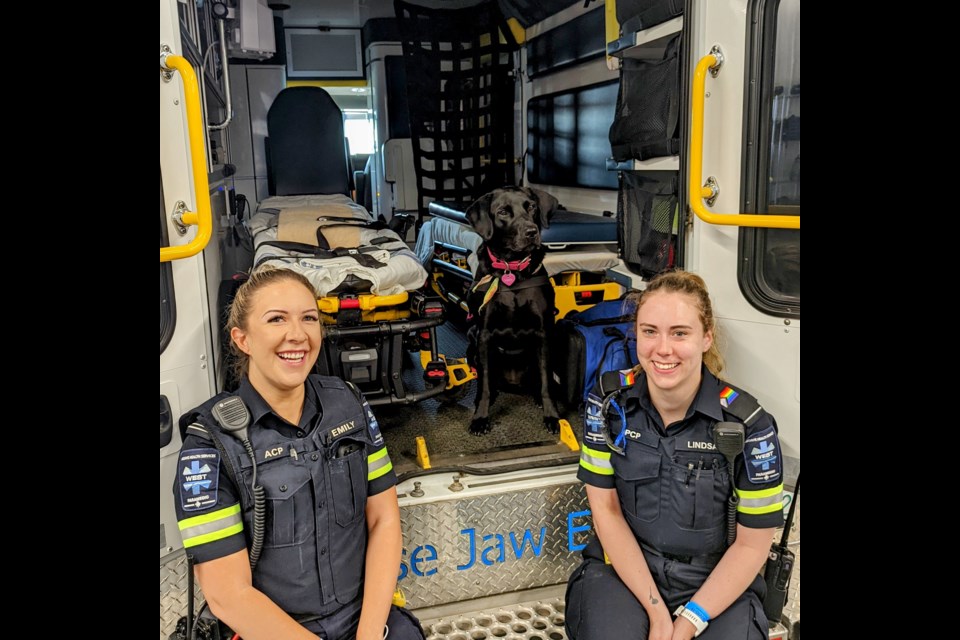Kyle Sereda, chief of Medavie Health Services West Moose Jaw (MHS West), said that adding Misty, a trained facility dog, to the crew of the paramedic station at 777 High Street West has been hugely positive.
Since bringing Misty onboard as the facility dog — and, more informally, as the health and wellness superintendent, with the rank insignia to prove it — Sereda has noticed a significant improvement in the mood of the station.
“The value that she has brought to the demeanour and the temperament of the crews, and just the mood, you know, it’s noticeable. And maybe it’s because we were so low during COVID, we were so overworked. Crews were given a lot, so maybe it was just timed well to bring in an animal like Misty.
“It doesn’t matter. She’s been with us for a while now, and she does her job.”
Sereda and his wife Angela, who was deputy chief at the time, began looking into improving their organization’s mental health and wellness program in late 2019.
Many of their staff have animals at home and the discussion turned to how much their pets help them.
Some of the paramedics live outside of Moose Jaw. During their “on” rotations, they don’t see their pets — or their families, for that matter — for days at a time. That can make coping with a hard day, or a particularly traumatic call, more difficult.
“There’s a good chunk of us that live in other cities and have to be away from our families and homes and pets when we’re working here,” said Emily Mireles, an advanced care paramedic. “We really like having Misty as our facility dog here. After coming back from a busy day or a bad call … she’s always ready to play and take your mind off things, so it’s nice having her around for that reason.”
Sereda said the facility dog idea grew even deeper roots when No Dog Left Behind (NDLB), a local training company, started bringing service-animals-in-training to the station.
“They’re training their service dogs, and coming in the ambulance, listening to the sounds of the sirens, things like that,” he explained.
Service dogs are highly trained
“We needed to get the dogs exposed to people in uniform, essentially,” said Derek Snow, lead trainer at NDLB. Training is done in progressive phases. “The first phase is adequate socialization to make the dog bombproof with people and environments, so that the dog doesn’t get spooked or scared or unsure of different situations or sounds, fireworks, lightning, all these things that can go against what they’re intended to be doing.”
The second phase is basic obedience training, and the third phase is obedience training with distractions added in.
NDLB trained Misty for 18 months using their broad experience with service dogs.
“Basically, Misty was trained to be a therapy dog for their facility,” Snow said, “with some tasks that are similar to how we train psychiatric service dogs.”
Snow believes training facility dogs could become an important part of his business.
“I think it could be an incredibly helpful tool in facilities like EMS spaces and fire departments and even police departments.”
Having a facility dog is uplifting for everyone
Sereda said that Misty seems uniquely intuitive to how individuals are feeling. She’s part of the station’s critical incident debriefing sessions, she hangs out with the crews while they do unit checks, and she will be along for presentations at schools and care homes.
“I was a little reluctant at first,” Sereda admitted. “Then, we learned that out of 30 paramedics, like 27 had animals, and I was like, ‘maybe there’s something to this.’ … Boy, was I wrong. It’s remarkable how Misty has lifted the spirits of our crews here.”
Lindsay Patton, a primary care paramedic who has worked at MHS West for a month, agreed.
“I actually did my student practicum here as well,” Patton said. “And, immediately, the first thing that I thought of is that my employer really cares about our wellbeing. … I did other practicums in other places and nobody had anything like Misty. And she’s been a big help.”
Other facilities have begun to show interest in having their own dog, and while Sereda said he’s happy to talk about it with them and encourage the idea, he must make one thing clear:
“First and foremost, I tell them they can’t have Misty,” he laughs. “She’s here, and the teams would probably revolt if we got rid of her.”


.png;w=120;h=80;mode=crop)

